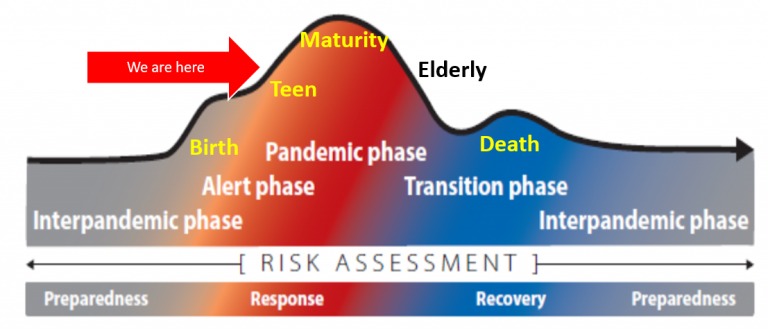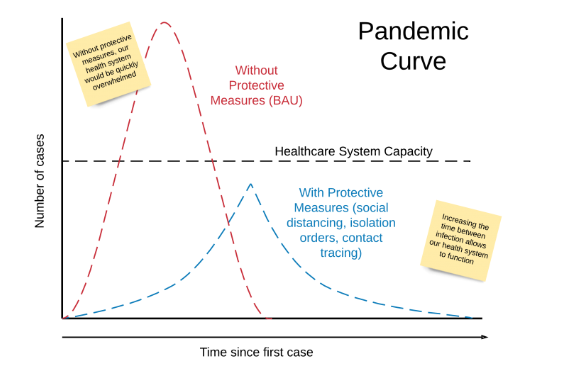The pandemic curve
To minimise the scale of COVID-19 infections, Australia has spent the last 3 weeks implementing stage 3 restrictions. The agonising question felt by most Australian’s is how much longer will the restrictions last? Unfortunately, at this stage there is not definitive answer available however, understanding the pandemic curve that is so often referred to in the media without necessary explanation will assist in defining the challenge that governments, business and the community all face.
To assist with understanding the pandemic curve, Resilient Services have used common terms to align the standard pandemic curve to the human lifecycle (see below).

Just the same as the human lifecycle, a pandemic curve has a limited life and will not last forever. A pandemic phase has a point where it begins referred to above as ‘birth’ and an end point referred to as ‘death’. In Australia, we are currently dealing with an unpredictable teenager compared to New York for example who are dealing with a more mature teen entering it’s prime of maturity and China whose COVID-19 pandemic is quite elderly and faces death. To differentiate a pandemic curve, from a general lifecycle, pandemics can arrive in waves and they also have the potential to restart.
Historically, without intervention a pandemic can last 8-12 weeks in each region or country it enters. After 8-12 weeks the pandemic is over, survivors build immunity and mass casualties will have been experienced. Readers may recall that England initially favoured the ‘Herd Approach’ which consists of allowing the pandemic curve to complete its natural cycle, without ‘flattening’. The Herd Approach relies upon Darwinism, or survival of the fittest. England have now abandoned the ‘Herd Approach’, in favour of flattening the curve, which is ironic considering the British Prime Minister is currently admitted into intensive care due to COVID-19 infection.
Curve flattening
We constantly hear about flattening the curve but what does this mean?

The primary reason for flattening the curve is to not overwhelm the capacity of the health care system. Although flattening the curve will result with the pandemic lasting many months, it removes the need for difficult healthcare decision making; such as who is eligible to be provided ventilators, and who is not? For example, Italy’s Healthcare System made the decision that patients aged over 60 years old are not to be given ventilators due to a lack of equipment, resources and ICU facilities. Can you imagine the devastation of families who find their loved ones excluded from medical care and the torment of medical doctors and nurses who must deny treatment to people who would otherwise make a full recovery? If England had of continued with the implementation of the Herd Approach, the British PM may have been excluded from lifesaving treatments.
When will we see the end of the Pandemic cycle and life return to normal?
Unfortunately, there is no forecast date available. The best guess for Australia is Spring 2020! The hope is that a commercially available vaccine is released, and the world can return to normal. A brand-new drug is estimated to be 18 months away however the greatest hope at this point is an existing vaccine invented for another purpose is successful in preventing or treating COVID-19 symptoms.
The most likely scenario for Australia is the curve flattening continues until person to person transmission of COVID -19 ceases for greater than the incubation period across Australia. As governments are likely to be cautious removing restrictions, no recorded infections would need to occur for many weeks greater than the 14 day incubation period.
We are all experiencing this unprecedented situation and it is so important we do our part and obey restrictions and closures to flatten the curve and contain the spread of COVID-19.

